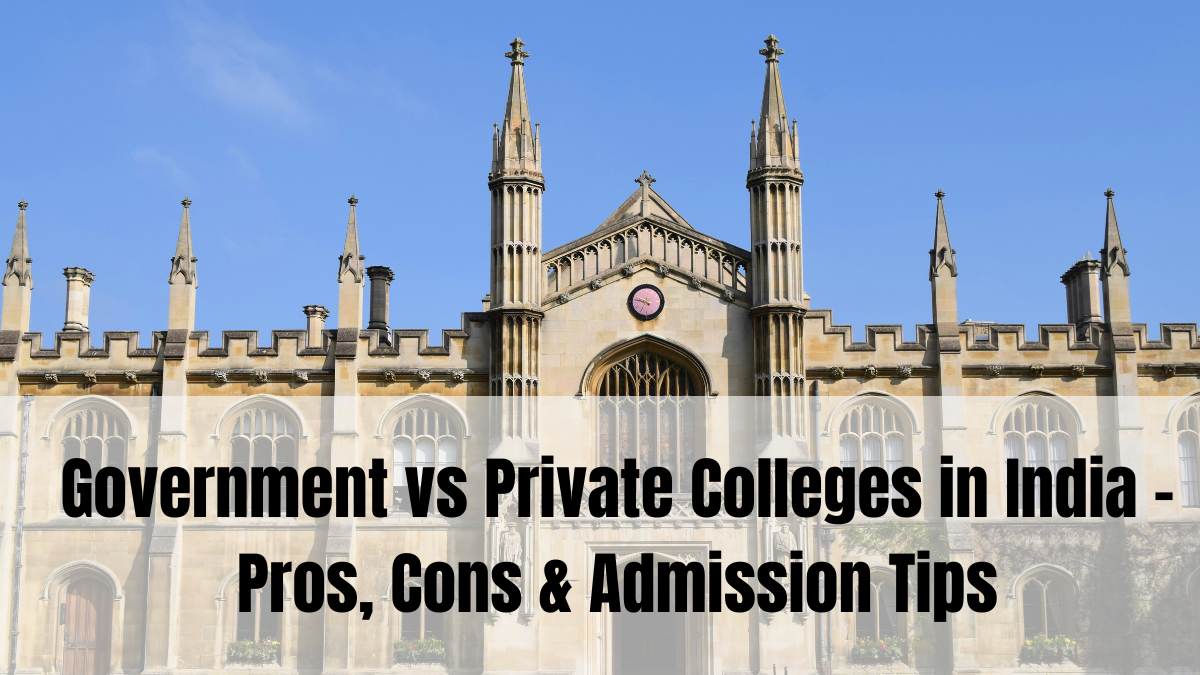As lakhs of students gear up for college admissions in 2025, one major question remains: government vs private colleges — which is better? The decision can shape your entire educational journey, career path, and financial burden.
This article offers a complete comparison between government and private colleges in India. From affordability and infrastructure to placements and faculty, we’ll break down the key differences so you can choose what suits you best.

What Are Government Colleges?
Government colleges are institutions that are fully or partially funded by the Central or State Governments. They include:
-
Central Universities (like DU, JNU)
-
State Universities and their affiliated colleges
-
IITs, NITs, AIIMS, and other prestigious public institutions
These colleges follow standardized admission processes like CUET, JEE, NEET, and other competitive exams.
What Are Private Colleges?
Private colleges are established and operated by private educational trusts or companies. They are:
-
Funded through tuition fees and private investments
-
Sometimes affiliated with public universities but run independently
-
Popular in professional courses like Engineering, MBA, Medical, etc.
Admission is often based on entrance scores, direct admission, or institutional criteria.
Government vs Private Colleges – Key Differences
Here’s a side-by-side comparison table to help you visualize the differences:
Factor |
Government Colleges |
Private Colleges |
|---|---|---|
Fees |
Very Low or Nominal |
High to Very High |
Funding |
Public (State/Central Govt.) |
Private Organizations |
Faculty |
Often more qualified, UGC-approved |
Varies across institutions |
Infrastructure |
May be outdated in some, excellent in top-tier |
Usually modern and upgraded |
Placements |
Good in top colleges, average elsewhere |
Excellent in top private institutes |
Research Facilities |
Strong in central universities, IITs, etc. |
Limited unless top-ranked |
Admission Process |
Competitive exams, merit-based |
Exams, donations, or direct admission |
Pros and Cons of Government Colleges
Pros
-
Affordable tuition fees
-
Recognized across sectors
-
Reputed faculty in central institutions
-
Good peer learning atmosphere
Cons
-
Limited seats, very high competition
-
Slower updates in technology and curriculum
-
May face administrative delays or outdated infrastructure
Pros and Cons of Private Colleges
Pros
-
Better infrastructure and digital facilities
-
Industry partnerships and exposure
-
Easier admission options
-
More focus on placements and internships
Cons
-
Expensive tuition and hidden fees
-
Wide quality variation among colleges
-
Over-commercialization in some institutes
Admission Tips – How to Choose Between Govt and Private Colleges
Here’s how to make an informed decision:
-
Check accreditation: UGC, AICTE, NAAC ratings matter more than brand names.
-
Evaluate ROI: Compare fees vs expected placement package.
-
Look for alumni reviews: What past students say is often more honest than brochures.
-
Consider location: Top colleges in metro cities may offer better exposure and opportunities.
-
Examine faculty & curriculum: A good college should update its syllabus as per industry needs.
FAQs
Which is better for engineering: government or private college?
If you qualify for an IIT, NIT, or a top state university, go for government. Else, top private colleges like BITS Pilani or VIT are excellent too.
Are private medical colleges in India worth it?
Only if you can afford the high fees and the college is MCI/NMC-approved. Many private medical colleges now offer excellent infrastructure and placements.
Do government colleges offer better job placements?
Yes, especially the top-tier ones. However, many private colleges with corporate tie-ups offer strong placement support.
Are government colleges always more affordable?
Yes, by a wide margin. Annual fees can be as low as ₹2,000–₹20,000 compared to ₹1–5 lakhs in private institutions.
Can I transfer from a private college to a government one?
In most cases, no. Colleges have independent admission processes, and lateral transfers are rare.
Click here to know more.
